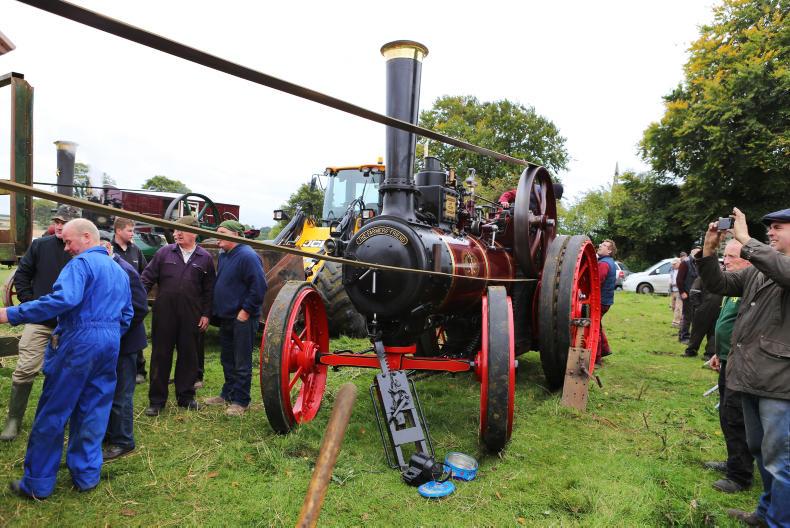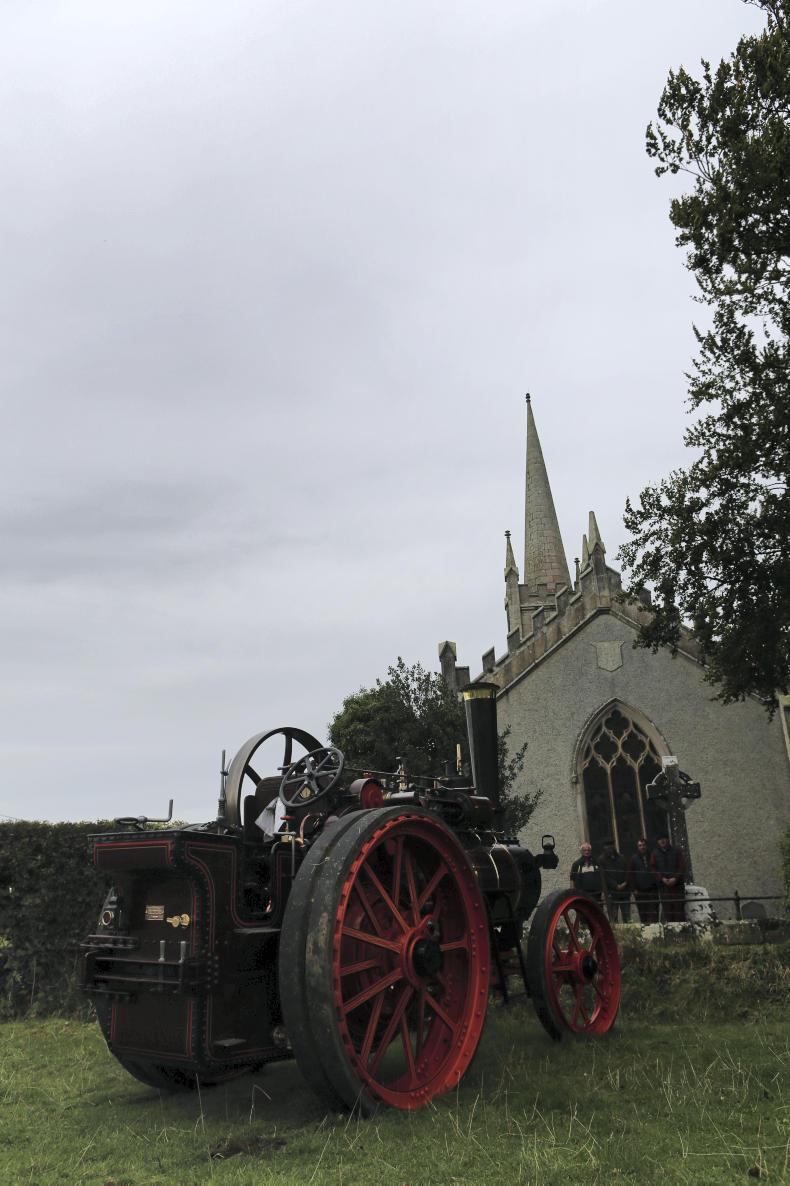
LOYALTY CODE:
The paper code cannot be redeemed when browsing in private/incognito mode. Please go to a normal browser window and enter the code there

LOYALTY CODE:
The paper code cannot be redeemed when browsing in private/incognito mode. Please go to a normal browser window and enter the code there
This content is copyright protected!
However, if you would like to share the information in this article, you may use the headline, summary and link below:
Title: In pictures: an 1889 traction engine in operation
One Kildare community threshing was organised to reunite the original buyer with the Marshall traction engine he purchased in 1889.
https://www.farmersjournal.ie/in-pictures-an-1889-traction-engine-in-operation-312863

ENTER YOUR LOYALTY CODE:
The reader loyalty code gives you full access to the site from when you enter it until the following Wednesday at 9pm. Find your unique code on the back page of Irish Country Living every week.

CODE ACCEPTED

You have full access to farmersjournal.ie on this browser until 9pm next Wednesday. Thank you for buying the paper and using the code.

CODE NOT VALID
Please try again or contact us.
For assistance, call 01 4199525
or email subs@farmersjournal.ie
Sign in

Incorrect details
Please try again or reset password
If would like to speak to a member of
our team, please call us on 01-4199525
Reset
password
Please enter your email address and we
will send you a link to reset your password

If would like to speak to a member of
our team, please call us on 01-4199525
Link sent to
your email
address
![]()
We have sent an email to your address.
Please click on the link in this email to reset
your password. If you can't find it in your inbox,
please check your spam folder. If you can't
find the email, please call us on 01-4199525.
![]()
Email address
not recognised
There is no subscription associated with this email
address. To read our subscriber-only content.
please subscribe or use the reader loyalty code.
If would like to speak to a member of
our team, please call us on 01-4199525
 This is a subscriber-only article
This is a subscriber-only article
Update Success !




Community threshings are a rare enough occurrence these days, letting people take a step back into the past.
One was held just close to the small church in Fontstown, Co Kildare.
It was organised to reunite the original buyer, Canon Richard Wolfe Bagot, with the Marshall traction engine he purchased in 1889.
Known as the ‘Farmer’s Friend’, the engine is the second oldest working engine in Ireland and one of the oldest of its kind in the world.
The story of the day begins when Willie Rochford researched the history of a steam engine his family had restored.
His painstaking search led him to its original owner, a Rev Richard Wolfe Bagot, of Fontstown Glebe, Co Kildare, in 1886.
Willie’s desire was to return to Fontstown with the engine and have a threshing day, to celebrate the engine going full circle.

Canon Bagot lived in the Manor House in Fontstown and is buried just metres away where the threshing took place.
Helped by local farmers Colm Flynn and Olivia Ashmore, a whole amazing story of post-famine agricultural initiatives by concerned people was unearthed. It is a story that seems lost in our nationalist history.
Canon Bagot had a deep understanding of the true causes of the famine and what was needed to bring agriculture in Ireland out of this mire.
Canon Bagot is famous for founding the model school and working farm in Athy in 1850 to help with farming methods under the church of Ireland.
He firmly believed it was education in agriculture, new technology and farmer ownership of these technologies that would create the base for a rebound from the squalor of post-famine Ireland.
He was instrumental in establishing the first farmer-owned creamery in Ireland, the first co-op creamery, model farm schools, dairy colleges, dairy factories and promoting technology through the RDS and Royal Agricultural Society.

He created a farm equipment store where machinery was provided for farmers to hire. The steam engine that the Rochford brothers have meticulously restored was part of this policy.
It was a joint effort between the Duke of Leinster and Bagot to make an engine, mill and elevator available to farmers for threshing.
Rev Bagot is an amazing, untold story, but we know that the foundation he laid resulted in the dairy industry of today. The story of his engine’s return has rekindled his story.
While Horace Plunkett is one of the best known from the past, the question to be answered is if Canon Bagot was the true brains behind the dairy industry of Ireland.
If so it should not be forgotten.
 Should you have more information on Canon Bagot and this important era of Irish agriculture contact Colm Flynn at flynnskerries@hotmail.com
Should you have more information on Canon Bagot and this important era of Irish agriculture contact Colm Flynn at flynnskerries@hotmail.com
1829–1894: Son of Canon John Bagot and Olivia Edwards, Richard followed his dad and granddad as rectors of Fontstown Church of Ireland.
Bagot was educated at the Industrial School in Lindfield, Sussex and afterwards at Kilkenny. He graduated in Trinity College and was ordained in 1852.
He took a proactive role in the promotion and development of agricultural activities throughout Ireland, especially in dairying. The decrepit state of rural Ireland is described in his submissions to the Devon Commission. He was a prominent member of both the Royal Agricultural Society and the RDS.
1860-1870: Ireland loses 60% of its butter market due to poor quality, to European high-quality butter. In 1870 Ireland exported 30,000t of butter to England.
1871: Canon Bagot organises the Great Agricultural Show in Ballsbridge, to promote a new approach to butter making.
1879: He organises around 800 Irish farmers to travel to the Great Agricultural Show in Kilburn, London.
1879: He, along with Mr Robertson, presented a report on the various systems of Continental butter-making. The first issue sold 5,000 copies. Gustav De Laval launches his continuous cream separator.
1880: He created a travelling educational dairy, consisting of lecturer, dairy maid and attendant to demonstrate new practices in butter-making, throughout Ireland. This resulted in a massive improvement in quality and an increase in sales of Irish butter into the London market.
1880’s: He created educational dairy colleges in Dublin and Cork, proposed the creation of eight dairy schools throughout the country. He travelled through France and Denmark to access their butter-making factories, often at his own expense.
1881: He organises an all Ireland presence at the London Dairy Show. His “Easy lessons on dairying” sells 5,000 copies.
1882: The organisation of co-operative creameries begins in Denmark.
1884: Canon Bagot establishes first farmer-owned creamery in Hospital, Limerick. It is the largest creamery in the British Isles.
1886: Canon Bagot publishes his handbook on dairy factories, creameries and home dairying. He stated his aim as ‘the dissemination of such practical information amongst our dairy farmers as will eventually be the means of keeping at home the greater part of the 14 million at present paid annually to foreign countries for butter”
1889: First co-operative creamery established in Drumcollogher.
1889: Order placed for Canon Bagot’s steam engine, a threshing mill and an elevator.
1889: Horace Plunkett returns permanently to Ireland, having spent the previous 10 years in the US.
1894: Canon Richard Wolfe Bagot dies and is buried at Fontstown.
In pictures: ‘Ford 100 Fest’ deemed a huge success
SHARING OPTIONS: